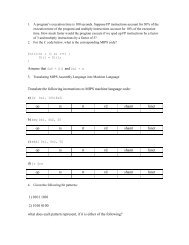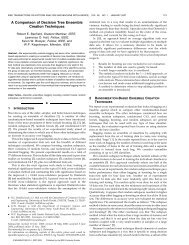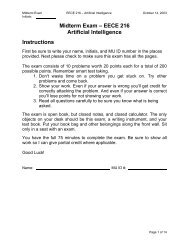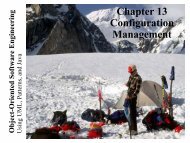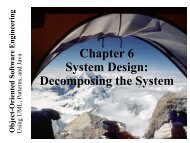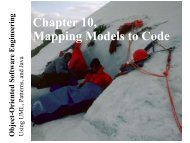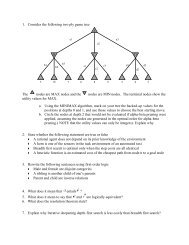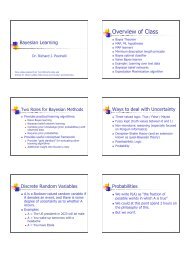ieee transactions on energy conversion, vol. 21, no - Richard J ...
ieee transactions on energy conversion, vol. 21, no - Richard J ...
ieee transactions on energy conversion, vol. 21, no - Richard J ...
Create successful ePaper yourself
Turn your PDF publications into a flip-book with our unique Google optimized e-Paper software.
880 IEEE TRANSACTIONS ON ENERGY CONVERSION, VOL. <strong>21</strong>, NO. 4, DECEMBER 2006<br />
Fig. 20.<br />
degrees.<br />
MMF profile of a faulty loop of the rotor cage over 360 mechanical<br />
Also, the mutual inductance between each two healthy loops<br />
is [10]<br />
L lm =(−1) µ ( )<br />
0rl α<br />
2<br />
. (A18)<br />
g 2π<br />
Meanwhile, the mutual inductance between a defective loop and<br />
healthy loop is<br />
L n b<br />
lm =(−1)µ 0rl<br />
g (n b +1)<br />
( α<br />
2<br />
2π<br />
)<br />
. (A19)<br />
Accordingly, the rotor inductance matrix is obtained as shown in<br />
(A20) at the bottom of the page, where L b and L e are the leakage<br />
inductances of rotor-bar and rotor end-ring, respectively.<br />
In a general case, the state-space representati<strong>on</strong> of the model<br />
of stator windings can be expressed as follows:<br />
v as = r as i as + dλ as<br />
+ v n (A<strong>21</strong>)<br />
dt<br />
v bs = r bs i bs + dλ bs<br />
+ v n (A22)<br />
dt<br />
v cs = r cs i cs + dλ cs<br />
+ v n (A23)<br />
dt<br />
where v n indicates the instantaneous <strong>vol</strong>tage at the neutral point<br />
of an assumed star-c<strong>on</strong>necti<strong>on</strong> for the stator windings. Meanwhile,<br />
the state-space representati<strong>on</strong> of the kth rotor healthy<br />
loop is given by<br />
0=2(r e + r b )i lk − r b i lk−1 − r b i lk+1 + dλ lk<br />
(A24)<br />
dt<br />
where r b and r e are the rotor-bar and rotor-end-ring resistances,<br />
respectively. Meanwhile, for the m th loop with n b adjacent<br />
broken bars the state-space representati<strong>on</strong> is given by<br />
0 = 2((n b +1)r e + r b )i lm − r b i lm−1<br />
− r b i lm+n b +1 + dλ lm<br />
dt<br />
⎡<br />
L r = ⎢<br />
⎣<br />
. (A25)<br />
Now, in order to eliminate the unk<strong>no</strong>wn neutral <strong>vol</strong>tage in the<br />
formulati<strong>on</strong> and also have a stiff set of differential equati<strong>on</strong>s in<br />
the case of an interturn fault, (A<strong>21</strong>) through (A23) are reduced<br />
to <strong>on</strong>ly two differential equati<strong>on</strong>s as<br />
v as − v bs = r as i as − r bs i bs + dλ ab<br />
(A26)<br />
dt<br />
v bs − v cs = r bs i bs − r cs i cs + dλ bc<br />
(A27)<br />
dt<br />
where the so-called line-to-line flux linkages, λ ab = λ as − λ bs<br />
and λ bc = λ bs − λ cs , are defined here as the state variables.<br />
Meanwhile, the state-space representati<strong>on</strong> of the additi<strong>on</strong>al<br />
fourth phase, representing the shorted porti<strong>on</strong> of phase-A, can<br />
be expressed by<br />
0=−r f i a +(r sc + r f )i sc + dλ sc<br />
(A28)<br />
dt<br />
where r f is the external resistor in Fig. 15 (i sc = i a − i f ), and<br />
r sc = ηr as . It should be pointed out that, if r f ≫ ηr as = r sc ,<br />
(A28) can be expressed by the following algebraic equati<strong>on</strong>:<br />
0=−r f i a +(r sc + r f )i sc + ηv as . (A29)<br />
Accordingly, L s in (A14) and L sr in (A15) are c<strong>on</strong>verted to<br />
3-by-3 and 3-by-(N bar − n b ) matrices, respectively.<br />
However, in general the state space representati<strong>on</strong> of the electrical<br />
porti<strong>on</strong> of the transient model can be represented by<br />
(d/dt)Λ = (−RL −1 )Λ + V (A30)<br />
where, in (A28), Λ is the vector of flux linkages, R, and L<br />
matrices are calculated using the formulati<strong>on</strong>s shown in (A31)<br />
at the bottom of the page, where R r is given by (A32) at the top<br />
of the next page. Meanwhile, matrix L in (A30) is calculated<br />
through two steps in order to eliminate the third row and the<br />
third column of matrix L p<br />
[<br />
L p =<br />
L ll +2(L b + L e ) L lm − L b ··· L n b<br />
lm<br />
L lm − L b L ll +2(L b + L e ) ··· L n b<br />
[L s ] 4×4 [L sr ] 4×(N bar −n b )<br />
[L T sr] (N bar −n b )×4 [L r ] (N bar −n b )×(N bar −n b )<br />
(A33)<br />
This is due to the fact that in (A28), V (1) = v ab = v a − v b , and<br />
V (2) = v bc = v b − v c . Meanwhile, the so-called “line-to-line”<br />
flux linkages are the stator windings state variables, namely<br />
Λ(1) = λ ab = λ a − λ b , and Λ(2) = λ bc = λ b − λ c . It should<br />
be <strong>no</strong>ted that in case of using (A29) instead of (A28), L s and<br />
L sr will become a (3-by-3) and a (3-by-(N bar − n b )) matrices,<br />
respectively [12].<br />
.<br />
.<br />
. ..<br />
. ..<br />
⎥<br />
⎦ .<br />
L n b<br />
lm<br />
L n b<br />
lm<br />
... L n b<br />
ll +2(L b +(n b +1)L e )<br />
⎡ ⎡<br />
⎢ ⎣ (1 − η)r ⎤<br />
⎤<br />
as −r bs −r f<br />
r<br />
R =<br />
cs r bs + r cs 0 ⎦ [0] 3×(N<br />
⎣<br />
bar −n b ) ⎥<br />
⎦ .<br />
−r f 0 r f + ηr as<br />
[0] (N bar −n b )×3 [R r ] (N bar −n b )×(N bar .−n b )<br />
lm<br />
⎤<br />
⎥<br />
]<br />
.<br />
(A20)<br />
(A31)




